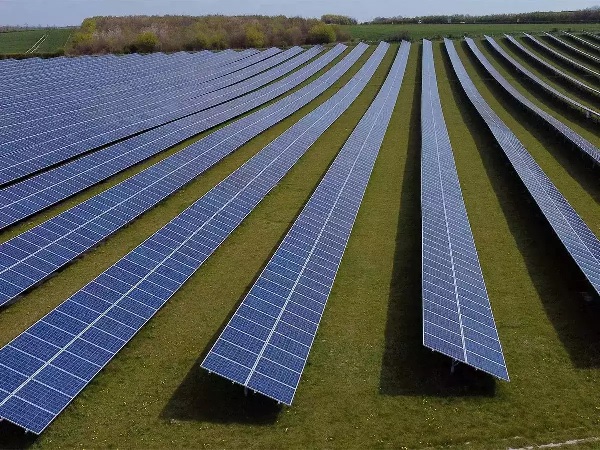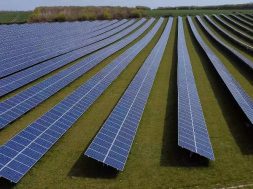
Only 2.56% of 10,000 MW decentralised solar power target achieved under PM-KUSUM in 5 years – EQ
In Short : Only 2.56% of the 10,000 MW decentralized solar power target under the PM-KUSUM scheme has been achieved in five years. This indicates significant shortfalls in meeting the scheme’s goals for expanding solar power in the agricultural sector.
In Detail : Centre introduced PM Kisan Urja Suraksha evam Utthaan Mahabhiyan in 2019 to make agriculture sector energy efficient. Only 6 states have even installed decentralised solar power plants.
New Delhi : Only 2.56 percent of the PM Kisan Urja Suraksha evam Utthaan Mahabhiyan (PM-KUSUM) scheme’s target of installing 10,000 megawatts (MW) of grid-connected solar power plants has been achieved since it was unveiled in 2019, revealed data provided by the Ministry of New and Renewable Energy in Parliament this week.
The scheme, aimed at making the agriculture sector energy efficient, entails the installation of 10,000 MW decentralised solar power plants on agriculture land, the installation of 14 lakh solar pumps, and solarisation of 35 lakh additional pumps. The target for completion is 2026.
Decentralised solar power plants are systems where solar panels are set up in a distributed manner, spread across multiple locations, but connected to a singular electricity grid. These require less land, and have solar panels set up close to locations where consumption is high like farms or rooftops of houses.
As of 30 June this year, the second component of the scheme has seen the most progress — the government has managed to install 7.12 lakh solar pumps out of the 14 lakh target. However, only 256 MW of the targeted 10,000 MW of decentralised solar power plants have been installed, and out of 35 lakh agriculture pumps, only 13,562 pumps have been solarised.
The Centre introduced the scheme to increase the income of farmers and provide sources of irrigation, and achieve de-dieselisation of the agricultural sector. State-wise data of PM-KUSUM’s installations also shows the wide disparity between states in terms of implementation. Only six states, with Rajasthan leading, have even installed the decentralised solar power plants. Of the total 7.12 lakh solar pumps that have been installed, 52 percent are just in three states — Rajasthan, Chhattisgarh, and Maharashtra.
Since PM-KUSUM is a demand-driven scheme, there are no specific state-wise targets or allocation. Hence, the data from different states indicates the demand and capability in those states for these solar installations.
Vibhuti Garg, director, South Asia, at the Institute for Energy Economics and Financial Analysis (IEEFA), an energy finance think tank, weighed in on the reasons for the current performance of the PM-KUSUM scheme.
“Initially, the high costs of installation prevented many small and marginal farmers from joining in on the scheme despite the government providing subsidies. It is a noble scheme but we need to ask, why would individual farmers spend to get electricity when they already get it free from the grid?” she said, referring to electricity subsidies provided by certain states to farmers.
“The way to go forward is that instead of solarising individual pumps, the policy should focus on solarising feeders which the DISCOMs should manage. It would help wider adoption of clean energy in agriculture,” suggested Garg.
Solar power dominates India’s renewable energy capacity
The renewable energy ministry also released information about the updated renewable energy installations up until 30 June across the country. A quick analysis of wind, solar, biogas, and hydropower distribution shows that solar power currently contributes the largest share in India’s total renewable energy capacity at 43 percent of the total 195 gigawatts (GW). Although wind power is available in only 10 Indian states, it still contributes to 23 percent of the total capacity, very close to large hydro power at 24 percent.
However, solar’s dominance remains. For context, just ground-mounted solar power installations make up 34 percent of India’s total renewable energy capacity, surpassing wind, small and large hydro, and biogas. While some projects like PM-KUSUM are lagging, overall, solar is still a big contributor to India’s renewable capacity and experts say it will continue to be so.
“The potential of solar is still much higher than that of wind since wind always has the requirement of a lot of land,” said IEEFA’s Garg, quoted earlier. “Solar might move to Decentralised Renewable Energy, or rooftop which does not require land but there’s no way you can install wind farms on rooftops, you will always need large tracts of land.”
State-wise renewable energy capacity data shows that Gujarat currently leads with 28,405 MW installed capacity, and close behind is Rajasthan with 28,171 MW. Interestingly, the two states have different specialties; Gujarat’s wind installations, for example, are double that of Rajasthan’s at 11,852 MW. At the same time, Rajasthan’s ground-mounted solar installations are around 18,000 MW, which is double Gujarat’s 9,000 MW. In total, these two states make up almost 30 percent of India’s renewable energy capacity.
On the other hand, states like Bihar and Jharkhand still haven’t hit 500 MW of renewable energy capacity. Other states like West Bengal and Chhattisgarh still have less than 2,000 MW installed capacity for renewable energy. But for comparison, Chhattisgarh’s ground-mounted solar capacity of 770 MW is still higher than Bihar’s entire renewable energy capacity of 450 MW.
Bio-power, which comprises biomass and waste-to-energy sources, makes up the lowest share in the renewable energy mix in India, at a total 10,948 MW. Some states that have performed well in this sector include Maharashtra, Karnataka and Uttar Pradesh, which make up 67 percent of the country’s total biogas production. Similarly, for both small and large hydro projects, Himachal Pradesh dominates with a 11,250 MW installation.
For large hydro, Uttarakhand too has a significant capacity of 4,971 MW, but it is still not close to Himachal’s. While the Niti Aayog has flagged huge hydropower potential in Arunachal Pradesh of up to 50,000 MW, the current hydro capacity of the state is only about 1,250 MW.
“Small hydro will be the way to go in the future, not just because of the energy but also because we need more storage and small hydro projects are compatible with pumped-hydro storage projects,” said Garg. “As for the hydro potential in the Northeast and other states, hydro has always had water-sharing and geopolitical angles to it, which is why it takes longer to build those projects.”












